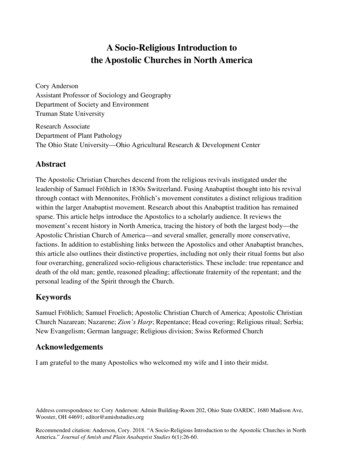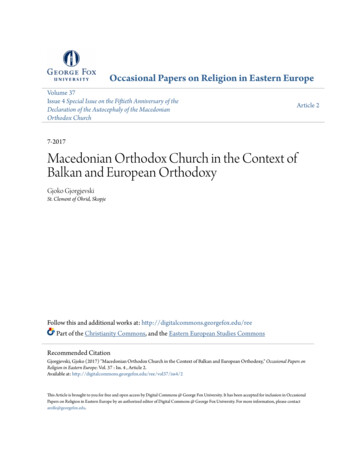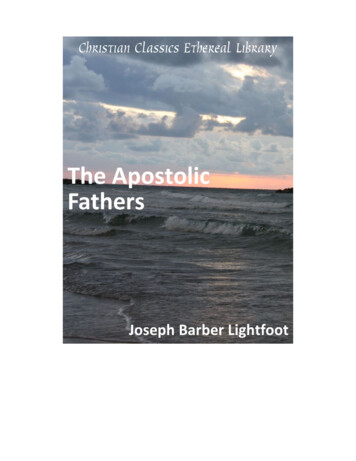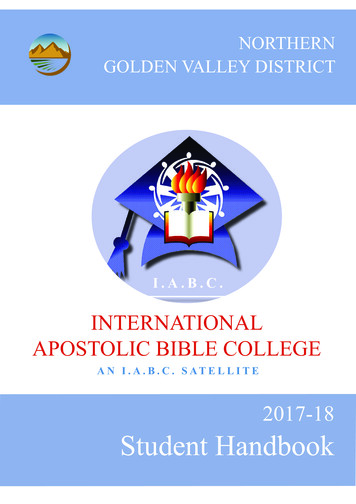
Transcription
Basil Chulev Tracing the origins of the first Christian community in EuropeMACEDONIAN AUTOCEPHALOUS APOSTOLICCHURCHЅкopje, Macedonia 2017
The intention of this essay is to provide simple and easy to understand overview of periodsfrom Macedonian Christian history and culture. It avoids substantial and detailedexplanations that consider wider historical background of the described events and persons,and is written primarily for those approaching the topic for the first time. It also avoidscomplex explanatory comments or insightful footnotes on the citations from the sources. Thegiven explanatory notes are prevalently etymological.The introduction comprises the periods from ancient history of Macedonia and presents abrief overall retrospective of advent of Christianity in Macedonia. The time-frame elaboratedas a main theme of this essay ranges from the beginning of the 1st century AD until today.The interpretations given here are meant to enhance our understanding and appreciation ofthe first Christendom in Europe. They are focused strictly on the Macedonian aspect of thestory disregarding the wider geo-political perspective.All the dates and references to centuries are „AD“ (lat. Anno Domini - used to indicate ourera after the commonly accepted date of Christ's birth) except where indicated otherwise.Throughout this essay, Macedonia/Macedonians generally refer to the area of the mainlandnorth of Mount Olymp (lat. Olympus), southeast of the Mount Šar (lat. Scardus) and west ofthe Rhodope Mountains. Macedonian peninsula refers to what is called „Balkans“ as of the19th century, occupying the part of southeastern Europe that lies south of the Danube andSava rivers and forms a peninsula bounded by the Adriatic and Ionian seas in the west, theAegean and Black seas in the east, and the Mediterranean Sea in the south.Latinized/Anglicized or Macedonic names are given in parenthesis, some names andtechnical terms are transliterated and these will be obvious when they appear. Other technicalterms and titles (e.g. Nova Roma, Iraklea, etc.) have been transliterated directly from theiroriginal forms with as few changes as possible: thus Iraklea rather than ‘Heraclea’, anddrouggarios rather than 'droungarios', which is neither “Greek” nor Latin.The terminology and concepts that are modern inventions (such as 'Hellenistic' or 'Greek')are altogether avoided. Such empirically wrong terms, used improperly by the modernhistoriography, were originally meant to describe totally different categories (such as theartistic periods) and were unknown to the ancient world. Their continued use perpetuatesmisleading assumptions.The modern-historiography 'privileged moments' are largely avoided too. For example - forhistorians today one such a privileged moment (of places and monuments as 'clasical') is'Clasical Athens', the Athens of the 5th and 4th centuries BCE. But when and why is soregarded? Was 'Clasical Athens regarded as “Clasical” already in antiquity? By whom?The definitions, current meanings and related concepts of the words in English are takenfrom the Oxford American Dictionary and Thesaurus (Mac OsX version 1.0.2 for PowerPC)and/or Meriam-Webster online dictionary. For the transliterated words in Macedonian is usedthe online ENCYCLOPÆDIA MACEDONICA (MAKEDONSKA ENCIKLOPEDIJA) vol.1 & 2, and online Macedonian dictionaries (idividi.com, off.net, etc.).The sources that were used are listed in the References at the end of this essay.
Contents:Tracing the origins of the First European Christian Community - Macedonian AutocephalousApostolic Church -------------------------------------- 7Macedonian Autocephalous Apostolic Church of Justiniana Prima (the origins of‘Christianimosity’) ----------------------------------- 21Macedonian Autocephalous Apostolic Church - Ohrid Archiepiscopacy ---------------------- 26Macedonian Autocephalous Apostolic Church - Ohrid Archiepiscopacy Literacy School andSt. Klement Ohridski University ------------------- 32Macedonian Autocephalous Apostolic Church - Ohrid Archiepiscopacy during the reign ofTsar Samoil and the emergence of Bogomilism - 38Macedonian Autocephalous Apostolic Church - Ohrid Archiepiscopacy between theCrusades and the emergence of the new nations -------------------------------------------------- 47Macedonian Autocephalous Apostolic Church - Ohrid Archiepiscopacy during theoccupation of Seljuk Turks ------------------------- 55Macedonian Autocephalous Apostolic Church - Ohrid Archiepiscopacy restoration inmodern times ----------------------------------------- 64The Symbols of Macedonian Autocephalous Apostolic Church - Ohrid Archiepiscopacy -- 67References -------------------------------------------- 72
Tracing the origins of the First European Christian Community Macedonian Autocephalous Apostolic ChurchMacedonians, the renown conquerors and rulers of the ancient world, are not distinguished only becauseof Alexander the Great and the empire larger even than that of the Romans, nor only because they are theeldest and maybe the only old nation of Europe that still preserved its original name as from 2450 BCE.They are also distinguished as the very first nation on the European continent that have invoked andaccepted the Christian religion at the very dawn of this era. Lidia, a young Macedonian woman fromPhilippi in Macedonia, was the first-ever baptized Christian on the European soil. In the MacedonianJerusalem, Ohrid, was founded the first ever known Christian church (St. Erasmo) on European soil in the3rd century AD, and is the ultimate Holy See of the old Patriarchate/Archiepiscopacy of Ohrid. There isalso the honorable platea of the first known university in Europe - St. Clement's University on Plaošnik.Above: the administrative division of the Roman provinces in Macedonian peninsula. Despitethe continuous changing and renaming of different areas on several occasions, throughout
the centuries they remained generally in the same boundaries as administrative regionsunder Romeian, and later under Turkish rule, until the 19th century and creation of the newnation-states. Nevertheless, Macedonia and Macedonian people remained the only nation inEurope that preserved their original ancient ethnic identity and name, unchanged for morethan 2400 yearsMacedonian Apostolic Church by succession is one of the four Ancestral Apostolic churches. 1 Forhaving a more clear idea of the geopolitical divisions in this part of the continent, with which thisdiscourse on the initial Christianization of Europe is dealing - the then Diocese Macedonia underRoman occupation was made up of the following administrative provinces: Macedonia Prima,Macedonia Secunda, Epirus Nova, Epirus Vetus, Thessaly, Achaia, and isle of Crete. Most of thesewere situated within the historical boundaries of the geographic Macedonia, once part of the ancientMacedonian empire, and subsequently a Roman province officially after 148 BCE.Below: map of the ecclesiastic division of Roman provinces in the Macedonian peninsulaon Dioceses in the 6th century (AD 535).1In explaining the official position of the Roman Catholic Church regarding the primacy ofChristian Churches in Eastern and Western parishes, Roman Pope Nicholas I (858-867) in thedistant 859 said: “Roman curia for true churches considers only those which were established byapostles, such as the - Macedonian, Roman, Antiochian and Aleksandrian church. Although thechurch clerics of Constantinople and Jerusalem call themselves ‘patriarchs’, however, that’swithout meaning, because they are not regulated by the apostles.”
After the division of Roman empire in Eastern and Western parts in AD 286, and effectively in AD 395,Macedonia became a proper of the Eastern-Romeian Empire, until the Turkish invasion in the 14thcentury. Nevertheless, even then it preserved its geographic, ethnic and ecclesiastic entirety. Thenafter inthe 19th century it was divided and further reduced under the occupation of modern neocolonial/politicalsubdivision (WW1 and WW2) to the present-day Republic of Macedonia.Above: Macedonia in its historical geographic borders, divided with the Balkan Wars (1912-1913)Thus, already in the first century AD, when Macedonia was still a province under Roman occupation, thepeople that today are under jurisdiction of the modern Macedonian Rightglorified2 Church - OhridArchiepiscopacy3, invoked and accepted the teachings of Apostle Paul, one of the first major Christianmissionaries and theologians. The Apostle was born in the year of the world 3998, or about two years“Pravoslavna” in plain Macedonian, from “Pravo”- rightful, and “Slavna”- glorified/celebrated(by glory of Jesus); i.e. “Orthodox (church)” in the western-Europe modern nomenclature.3 Makedonska Pravoslavna Crkva - Ohridska Arhiepiskopija in transliterated plain Macedonian,abbr. MPC-OA; a Christian Church descended from the ancient Macedonic Christian religion andofficial national church of today Macedonia. Like the other Orthodox Churches MPC-OA doesnot recognize the authority of the Roman pope and uses its own elaborate and ancient forms ofholy service. The chief Orthodox Churches (often known collectively as the Eastern OrthodoxChurch in western Europe) beside Macedonian include the national churches of: Albania,Bulgaria, Grease, Moldavia, Montenegro, Russia, Romania, Serbia, Ukraine, White Russia (i.e.Belarus), etc. The term “Orthodox” is also used for other ancient churches, mainly of African orAsian origin, e.g., the Coptic, Syrian, and Ethiopian churches.2
before the advent of our Lord. He was a far-famed Doctor of the Law, a person of great wisdom, a man ofauthority and eminence. Around Macedonia also preaches the Apostle Andrew, who sets apostle Urbanfor first episcope in Macedonia.Above: St. Apostle PaulPaul took this most important step of carrying over the doctrine of the Gospel from Troas to Macedonia inAD 51-54, and from thence spreading it further in the countries across the rest of Europe. He made threemissionary voyages in Macedonia. His voyages in Philippi, Ber (Lat. Beroia), Solun, and other places in
Macedonia are widely known. Nonetheless, archaeological and other evidences show that beside thesethree cities in the first century AD in Macedonia were formed many other early Christian communities - inAmfipolion (Lat. Amphipolis), Bargala, Iraklea Linkesta (Lat. Heraclea Lynkestis, today Bitola), Lihnid(Lat. Lychnidos; today Ohrid), Skopje (Lat. Scopis), Stob(i), Tiveriopole (Lat. Tiberiopolis), etc. It is quitein the spirit of Macedonic antiquity (a spirit which was by no means familiar to the author of the Acts ofthe Apostles) that so important an era, including so much of the future history of the cause of the Gospel,should be inaugurated by a vision that came in Apostle Paul’s vision. In this vision a Macedonian manappeared to the Apostle Paul with a prayer that he should go over to Macedonia and help them (XVI.9).At the time this happened Paul was at Troas, the capital city of a small country of the same name, situatedto the west of Mysia (in Asia Minor), and on the borders of the Hellespont. This city, built by Lisimach(Lat. Lysimachus), one of Alexander's famed chelniks4, was peopled from the neighboring Macedonicplaces, and originally called Alexandria, or Troas Alexandri, by the builder, in honor of his great leader.But, it soon lost its more distinguished Macedonic name, and with the surrounding country retained that ofTroas merely, and in the Apostles days it was a noted sea-port, where travelers from the upper parts ofAsia usually embarked for Thrace and Macedonia.While remaining there, apparently in a state of uncertainty as to his future movements, Apostle Paulbeheld in the night time a vision, which at once determined him as to the course he should pursue. AMacedonian man stood before him, and besought him to pass into Macedonia to their assistance. Literarily4“Chelnik” - chieftain, general; a ‘military leader’ in plain Macedonian.
as written in the Bible: a Macedonian stood on the far shore and called across the sea, “Come over toMacedonia and help us!” (Acts of the Apostles 16.9)Paul immediately related the importance of the vision to Luke, Silas, and Timothy, who, with one accord,regarding it as a direction from heaven, willingly obeyed the requisition, and setting out from Troas, camewith a fair wind directly to the legendary Samothrace. St. Paul, however, did not even land on the island,but, passing by, landed at Neapolis. Nonetheless, he and his companions didn’t stop there. They nextproceeded to Philippi. It lay about fifteen miles distant from Neapolis, and was the chief city of that part ofMacedonia. The bibles also testify that Macedonia is the country where the first ever Christian on theEuropean soil - a woman named Lidia from Philippi, was baptized first and converted to Christianity.The occurrences which are said to have taken place during the first Apostle's visit to Philippi, inMacedonia, belong to the most miraculous order of those which the Acts of the Apostles relates of him.Whilst Paul and Silas, it is stated, were spending some days in Philippi, they were followed, wheneverthey took their way outside the city, by a young woman possessed with a spirit of divination, with the loud
cry, "These men are the servants of the Most High God, who show us the way of salvation." After thedamsel had followed them for many days, Paul converted and blessed her in the name of Jesus Christ.For prophesying the new teachings of Christianity the two Apostles were soon thrown by the Romanoccupying authorities into the deepest prison, and held in the strictest confinement. But, as the Acts of theApostles tell us further - at midnight Paul and Silas raised a loud hymn to god, heard by all the prisoners,which was followed immediately by a powerful earthquake, that caused the doors of the prison to bethrown open and the fetters of the prisoners to be loosed. At the sight of the open doors the jailer thoughtthat the prisoners had escaped. But when Paul called out to him with a loud voice that they were all there,and he, falling at the feet of Paul and Silas, asked, "What must I do to be saved?" The answer was,"Believe on the Lord Jesus Christ."Further, Apostle Paul passed through Amphipolion and Apolonia, as the missionary journey lead him toPeloponnesus. Amphipolion was built about five hundred years before the Christian era. It was the capitalof the first division of Macedonia, situated on the banks of the river Strumon (Lat. Strymon, today riverStruma), and contained about ten thousand inhabitants. Apollonia was also a city of Macedonia, betwixtAmphipolion and Solun, and, although not of so much consequence as the former in any point of view,had yet sufficient importance to attract the Apostle's attention.After that he returned to Asia Minor and stayed for sometime in Ephesus, and after visiting Jerusalemonce again, Apostle Paul returned back in Macedonia. In this second journey, his deputies, together withTitus, Jason, and Luke, the sacred historian, who had now rejoined him, accompanied the Apostle intoMacedonia, at one of the cities of which the deputies separated from the remainder of the company, andproceeded forward to Troas to await their coming.Even if there’s no detailed historical records for his second voyage road itinerary, it must be assumed thatSt. Paul on his way to Matia and Dalmatia, must’ve passed somewhere through the western parts ofMacedonia, otherwise he should’ve fly over, which for those times is very unlikely. So, undeniably healso passed through ancient Macedonian cities of Iraklea Linkesta and Lihnid (i.e. Ohrid). This was theroute of Via Egnatia, the ancient Roman road, laid upon the track of even more ancient Macedonian roadbuilt by great kings of Ancient Macedon. He visited again Philippi, Solun, Ber, and other places at whichhe had formerly established churches, teaching and exhorting the disciples to remain steadfast in the faith,and to look forward with the full assurance of receiving the glorious reward that would ultimately betheirs. Having thus, as far as lay in his power, discharged his duty to the absent churches, the Apostleproceeded through the remainder of Macedonia on his errand of charity, and even prolonged his preachinginto Matia and Dalmatia, an extensive provinces to the northwest of Macedonia.St. Paul, with Titus, Jason, and Luke, after tarrying a short time longer in Macedonia, and celebrating thefeast of the passover at Philippi, sailed from thence by Neapolis, and after a voyage of five days rejoinedthe deputies back at Troas, having occupied about ten months in this mission, from the time he leftEphesus till its conclusion.The third voyage of St. Paul to Macedonia happened to be after long journey to Rome, where he was takenas a prisoner. In this voyage Luke, the sacred historian, and Aristarch, the Macedonian, accompanied him.Two years after he was freed, but then he went to Spain, and thenafter by crossing through France hearrived as far as Britain, which at that period was Roman colony too. After the lapse of nine monthspassed in Spain, France, and Britain Paul embarked on shipboard, and proceeded by sea to Crete, a voyageas long and as perilous as any he had ever undertaken. Then he returned once again to Judea andJerusalem from where he went back to Macedonia for third and last time. Apostle remained at Nicopolistill the winter had passed away, after which he resumed his labors, and passed through the greater part of
Macedonia. He then embarked at Cenchrea, and, crossing the Aegean Sea, landed once more at Troas,from which, after a short stay in that city, he proceeded to visit Timothy at Ephesus.During his long journey in the western Europe the Apostle undoubtedly suffered many of thosepersecutions and afflictions which awaited him wherever he went, and which were so admirablycalculated to prepare him for the now fast-approaching termination of his earthly avatar. It is supposedthat at Ephesus he received a divine intimation that his labors were nearly at an end, his sufferingsdrawing to a close, and that he must, ere long, gain the crown of martyrdom at Rome. He bade farewell toTimothy, his most dear and valued friend, and then, with characteristic firmness, set his face towardsRome. And although now bending under the weight of years, journeyed with a light heart to meet hisimpending fate. The manner in which his last journey was accomplished is involved in obscurity. Somethink that the Apostle passed through Macedonia, again visiting the churches he had planted there, and,crossing the Adriatic Sea into Italy, proceeded by land to Rome. Others are of opinion that he embarked atEphesus, and went to Italy directly by sea. This is more probable.
St. Paul arrived at Rome for the second and last time soon after the commencement of the first generalpersecution of the Christians in the reign of the tyrant Neron. The Apostle was pointed out to thisinstrument of tyranny and oppression as the principal leader of the obnoxious sect, and instantimprisonment was his lot. The crown he panted for, he soon obtained. The evil-minded hatred forChristianity returned to Rome. Paul was taken from prison, and with but little form of trial, condemned todeath; the only privilege accorded to him being that, as a Roman citizen, he should suffer by the sword.Christian belief brought by St. Paul in Macedonia found wide popular acceptance and firm strongholdthere since the apostolic times in first place because of Christianity role as opposition movement to theRoman yoke. Macedonians, notorious for their constant rebellions and never ending struggle for freedom,found new hope in Jesus and monotheism.Facing the widespread popular acceptance of the new religion, the pagan Roman occupators, starting fromthe time of Neron (AD 54-68) channeled their desperate practices of oppression and tyranny toward theChristians with cruel inquisition-styled pogroms. The storm of persecution having thus commenced, itarose, ere long, to the height of an ungovernable tempest, which soon dispersed further the ill-fatedChristians of Macedonia. From this wretched barbaric period of the human history remained theproverbial saying of “throwing to the lions”, hence the Christians were really thrown to the lions forpublic amusement in Roman circuses.“Their name is coming from Christus, who was executed in the time of Tiberius by one of our procurators,Pontius Pilate; and this very dangerous heresy, even if halted for a moment, not only reappeared again inJudea, where was the source of this evil, but in Rome too, where all disgusting and shameful things findrecovery and popularity The killed (Christians) ones are laughed publicly, they were raged and thrown
to the dogs, or crucified and put on fire like the torches in the night ”5 Almost absolute absence ofChristian temples from these first centuries of Christ Era testifies the ruthless persecutions by Romanstoward any manifestation and symbol of Christianity. Thenafter, despite the incessant bloody oppressionand inhuman treatment, near the Macedonian Jerusalem, Ohrid, in the 3rd century AD was founded andbuilt the first ever officially known Christian abbey/church on European soil - the church of St. Erasmo(Lat. Erasmus), of which the ancient remains were recently discovered. With this small church in the 3rdcentury were laid the foundations of the nearby future ultimate institution and autocephalous Holy See ofthe Macedonian Apostolic Church - Ohrid Archiepiscopacy.Above: an ikon of St. Erasmo5Cornelius Tacitus, Annales 15, 44, ed. Charles Dennis Fisher (Oxford: Clarendon Press, 1906)
The last desperate Roman emperor that tried to bring back the old pagan beliefs was Flavius ClaudiusJulius. During his reign of terror in Macedonia were slaughtered the 15 Tiberiopolis Martyrs (Sv. 15Tiveriopolski Mačenici). Their martyrdom cult and worship spread across Macedonia and abroad, and iscelebrated by Christians in Macedonia until today.In AD 295, the reforms of Diocletian (284-305) had seen Macedonia assigned under Diocese Moesia, oneof the twelve newly established Dioceses of the Roman empire. From the until-then one and uniqueProvince of Macedonia three administrative provinces were carved: Macedonia, Thessalia and EpirusNova. Soonafter the dioceses became 14, as Diocese Moesia was again divided in two - Diocese Daciaand Diocese Macedonia. And the Provinces of Macedonia, Thessalia and Epirus Nova were reassignedagain under the Diocese Macedonia. Then emperor Valentian II (364-375) created the province ofMacedonia Salutaris that comprised Macedonia and Dacia, and so on Above: illustration from ‘Cosmographia Scoti, Notitia dignitatum’. Etc. folio no. 090vBasel,1436
The centennial Roman terror against the Macedonians in the occupied Macedonian territories continuedwith the same barbaric obduracy, but now focused especially on the Christian Macedonians. This terrorlasted until AD 313, when the oppression against Christians was finally halted by the emperor Konstantin Ithe Great. He recognized and permitted the practicing of Christianity as one of the religions in the Romanempire. On top of that in AD 330 the capital of the empire was transferred by Konstantin into his newlybuilt city on Bosporus, Konstantinopolitana Nova Roma (Latin: Constantinopolitana Nova Roma,anglicized: Constantinople). No one in the old world expected such a striking event and switch of thebalance that sent shock waves across the whole Mediterranean. This geopolitical earthquake gave the newimpetus to the Macedonian Christian community, and particularly to the Macedonian church and its parexcellence central position in Macedonian peninsula. Thus, the Christianity was finally legalized byemperor Konstantin I the Great in AD 324, and the church in Konstantinopolitana Nova Roma becameEcumenical (i.e. Imperial) Patriarchate. Then, Roman inhuman policy of assimilating everyone andeverything by sword and flame was now adopted by their very victims, i.e. the Christians, when theyfinally succeed in coming to power at the end of the Roman empire in the fourth century AD. In AD 380due to its mass acceptance, Theodosius I even proclaimed it as the state religion. Then, already widelyaccepted Christianity, sprang out of illegality in Macedonia as well.The astonishing move of the emperor Konstantin was strongly contested by the churches in Alexandria,Antioch and Rome. These self-admiring execrate churches simply didn’t expect such an unpredictabledevelopment from this great monarch of Macedonic origin, as they were all aiming to become the
exclusive center(s) of the new universal credo. But, Konstantin I the Great blew away their blasphemousdreams of monopoly over Christianity.Although, these intransigent events didn’t change much the extremely complicated position of the newlyestablished Diocese Macedonia, as the Macedonian Apostolic Church found itself in the middle betweenthe hammer and anvil of the powerful spheres of interest of old Rome and New Rome i.e. Constantinople.Macedonia became the axis around which the ecclesiastic schisms of east and west will contort during thefollowing centuries, and Macedonian Apostolic Church a contested Christendom in the middle betweenthe other two, over which the Eastern and Western congregations will fight incessantly ever since. A direexample of how the other churches comported toward the Macedonian Apostolic Church is the AD 381letter of the pope Damasi I (366-384) in which he calls on the episcope of Solun, Acholiy, to “stand firmlyagainst the ‘Macedonic heresy’(?) ”6 Today, two millenniums after, the Macedonian Apostolic Churchis still largely opposed and in treacherous denial by most of the modern politically-biased and dividedmodern churches, which stubbornly try to excommunicate this most oldest of all European churches. Oncestrongly forbidden and unthinkable “church nationalism” become the rule when the power of theEcumenical Patriarchate declined in the 13th century. Instead of god’s love and brotherhood - immorality,politics, territorial and other “greater” interests prevailed over the initial pure Christian credo professed bygod’s disciple on earth, Jesus Christ.After the legalization of Christianity on behalf of Konstantin I the Great, within the Diocese Macedoniamany Macedonian cities were risen into Episcopal Sees, testimonies of which we have in the records ofparticipants of the first holy synods of all churches: the metropolitan episcope Dake (Lat. Dacus) from theSkopje episcopacy (Lat. Episcopae Scopis), and Budimir and Evagriy of Stob(i) episcopacy are noted inthe records of the very First Ecumenical Holy Synod of all churches in Nicaea in AD 325.From the testimony of Eusebius the Caesarian we also know that the episcope from Macedonia indeedparticipated on the Holy Synod in the city of Tyre and on the inauguration of the Holy Temple built byKonstantin I the Great on the (supposed) tomb of Jesus Christ in Jerusalem in AD 335: “The emperormade godsend laws and gave great tribute by ordering around the cave in which the savior was born agreat and marvelous temple to be erected, deign of god. Episcopes from all provinces participated theblessing of the church. Thus Jerusalem became the centre of many archiereyes from all the provincesand the whole city became a mess of many servants of god. Macedonians too sent an episcope from theirmetropolis.”7As participants of the Holy Synod in Serdica in AD 343 are mentioned the episcopes: Aeciy from Solun,Antigon from Bela (Lat. Pella, the ancient capital of Macedonia), Paregoriy of Skopis (today Skopje),Evagriy of Iraklea (today Bitola), Basus of Diocletianople, Porphyry of Phillipi, Paladiy of Dion, Gerontiyfrom Beroia, and Zoxim of Lihnid (i.e. Ohrid);8Macedonian episcopes were present also on the Second Universal Holy Synod of all churches inConstantinople in AD 381; on the Ephesus Holy Synod in AD 449, where the episcope Petko (Lat. Quintil)participated; on the important 4th Ecumenical Holy Synod in AD 451 in Chalcedon, Bitinia, where werenoted the episcopes Dardany from Bargala and Nikola from Stob(i); etc. etc.6‘Damasi Papae ad Acholium et Alios Macedoniae episcopos,’ Epistola V, 365–369 (PL 13);Damasi Papae ad Acholium Thessalonicensem episcopum, Epistola VI, 369–370 (PL 13); J.Baco.7 “De Vita Constantini,” by Eusebius from Caesarea IV, XLIII p. 25.8 Mansi III, col. 38–39, 42–49.
According to archaeologic, epigraphic and other evidences from Macedonia, confirmed early Christianepiscopacies in the IV century (when Christianity was officially recognized and legalized as religion) are:Apolonia, Dion, Lihnid (Lat. Lychnidos, today Ohrid), Partikopol, Amfipolion, Cassandrea, Serr(es),Arg(os), Iraklea Linkesta, Stob(i), Bargala9, Harmonia, Kalenidin, Zapara, Dober, Tiveriopol, Scopis (i.eJustiniana Prima, today Skopje), etc.9Founded by St. Jerome (lat. Hyeronimus) in the 4th century.
Macedonian Autocephalous Apostolic Church of JustinianaPrima, the origins of ‘Christianimosity’In AD 535 Macedonian Apostolic Church finally received the recognition of its inhered dignities and Godgiven title, and was officially equaled by its apostolic right on the same level with the other apostolic andnon-apostolic churches and holy sees in Konstantinopolitana Nova Roma, Rome, Alexandria, Antioch andCyprus. The Romeian emperor Justinian I the Great then on 14 April 535 decreed in his Novel 11 10 theelevated status of Episcopal city of Skopje (Lat. Scopis) into independent Auto
authority and eminence. Around Macedonia also preaches the Apostle Andrew, who sets apostle Urban for first episcope in Macedonia. Above: St. Apostle Paul Paul took this most important step of carrying over the doctrine of the Gospel from Troas to Macedonia in AD 51-54, and from thence spreading it further in the countries across the rest of .










